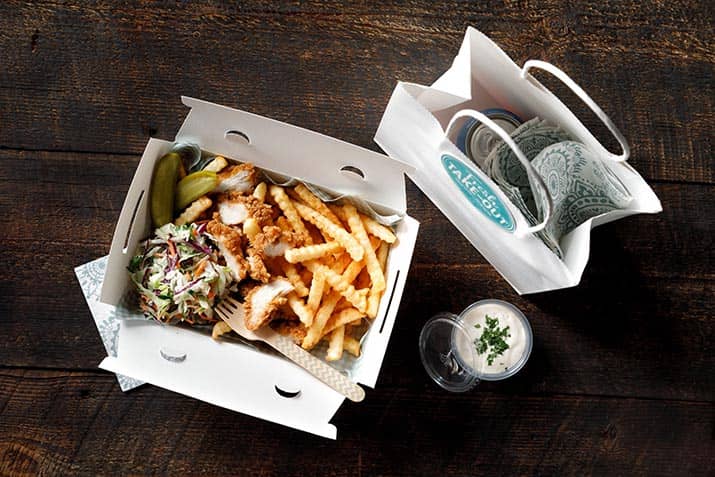Full Service Restaurant | Food Trends
The Future of Off-Premise Ordering for Restaurants
Jul 05, 2023

The pandemic forced countless restaurants to figure out how to serve their customers off-premise efficiently. For many, the learning curve was steep and fast.
But now, operators are taking a harder look at their off-premise programs with an eye toward optimizing processes and profitability. Because while the industry continues to evolve, off-premise has established itself as a pillar of the business: 78% of operators surveyed now say off-premise services are a strategic priority for their operation.1
In this article, you’ll get an update on off-premise growth and learn how operators are tweaking their off-premise service now that the crisis has passed.
Off-premise dining continues to grow, just more slowly
In 2022, the off-premise channel saw a 1% growth in 2022 vs. 2021, following the market’s overall growth. But that growth was unevenly shared:
Restaurant Off-Premise Food & Beverage Sales Growth YOY 2021-20221
Third-party delivery +8.1%
Total restaurant +7.5%
Drive-thru +5.6%
Delivery +5.2%
Total off-premise +1.0%
Self-delivery +0.1%
Takeout -5.8%
Restaurant Food & Beverage Sales By Channel in 2022
Drive-thru 40%
Takeout 37%
Delivery 23%
In the near term, expect ongoing fluctuations between delivery and pickup options, as well as shifts between first-party and third-party orders, as consumers navigate inflation.
These days off-premise is about optimization vs. adoption
For full-service restaurants, 10% of their business has shifted to off-premise since early 2020. For limited-service restaurants, that number is 15%. So consider the adoption phase of off-premise officially over; now operators are keen to optimize this service mode for higher profits. In fact, 78% plan to increase future investments in their off-premise menu.
Operators are scrutinizing their off-premise program on all fronts—from reevaluating packaging and customer-facing technology to offering fast, accurate service that maintains quality.
Consumers’ approach to off-premise is evolving as well.
According to Technomic, they’re increasingly opting for order-ahead pickup and drive-thru service—the least costly off-premise options—in the face of inflation. This is putting additional pressure on restaurants to work faster and more accurately without sacrificing quality.
To protect margins, operators have been actively seeking methods to encourage customers to use their own ordering platforms instead of relying on third-party services.
The fight to own the customer continues
One way restaurants drive customers to their proprietary ordering platforms is by asking higher prices on third-party apps like DoorDash and Uber Eats.
According to Technomic, half of operators charge higher prices on third-party sites.1 Consumers would prefer they didn’t: about 50% believe that pricing should be the same no matter where the order originates, and 73% have noticed the higher prices on third-party apps.1
On average, consumers have about three apps for a specific restaurant and three apps for third-party delivery services.
Still, since 2021, there has been a notable transition away from operators primarily utilizing their own websites for digital ordering. Instead, a preference has emerged for third-party apps and websites. DoorDash and Uber Eats are the most popular among operators and consumers.
The bottom line: Having a digital ordering platform today is not enough. It needs to be evolving constantly to improve useability for all ages, offer personalized experiences, and provide the just-in-time order tracking that time-starved customers love.
In light of those demands, third-party services may be the best option for many operators, especially independents.
On the other hand, quick-service restaurants are having significant success luring their customers away from third-party apps by introducing loyalty functions into their apps.
French fries still reign as the most-ordered side in off-premise
French fries continue to outsell all other sides in every format of off-premise: drive-thru, takeout and delivery.
Percentage of Customers Who Order French Fries
70% Drive-thru
65% Takeout
53% Delivery
Still, 5% of operators avoid offering fries on their off-premise menu, fearing they’ll arrive stale and soggy at their final destination. This is a legitimate concern with conventional fries: during the pandemic, fries drew the most complaints on delivery orders.
But innovative products like Simplot Delivery+® Fries, introduced in 2021, have been game changers.
- On the clear-coated side, Simplot Conquest® Delivery+® Fries offer the industry’s longest hold time: they stay crisp and delicious for 40+ minutes after cooking.
- For seasoned/battered fries, operators can count on Simplot SeasonedCRISP® Delivery+® Fries to keep their crispness for 30+ minutes.
In all, Simplot now offers 19 Delivery+® fry products, so there’s really no reason not to offer fries—the industry’s most profitable food item—on your off-premise menu.
The quest for off-premise profitability continues for restaurants
The urgency to adapt fostered by the pandemic spurred many operators to jump into off-premise with little or no experience. But time has passed, and some solutions that worked in a pinch no longer serve you well. Now’s the time to look at your off-premise approach and make those overdue adjustments.
1Technomic, Inc., 2023 Off-Premise Multi


